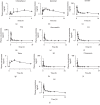Simultaneous Determination of 13 Constituents of Radix Polygoni Multiflori in Rat Plasma and Its Application in a Pharmacokinetic Study
- PMID: 32190053
- PMCID: PMC7072103
- DOI: 10.1155/2020/4508374
Simultaneous Determination of 13 Constituents of Radix Polygoni Multiflori in Rat Plasma and Its Application in a Pharmacokinetic Study
Abstract
Radix Polygoni Multiflori (RPM) has been widely used to treat various diseases in Asian countries for many centuries. Although, stilbenes and anthraquinones, two major components of RPM, show various bioactive effects, it has been speculated that the idiosyncratic hepatotoxicity induced by RPM may be related to these constituents. However, information on the pharmacokinetics of stilbenes and anthraquinones at a subtoxic dose of RPM is limited. A simple and sensitive UPLC-MS/MS bioanalytical method for the simultaneous determination of 13 ingredients of RPM, including chrysophanol, emodin, aloe-emodin, rhein, physcion, questin, citreorosein, questinol, 2,3,5,4'-tetrahydroxystilbene-2-O-β-D-glucoside, torachrysone-8-O-glucoside, chrysophanol-8-O-β-D-glucoside, emodin-8-O-β-D-glucoside, and physcion-8-O-β-D-glucoside, in rat plasma was established. Acetonitrile was employed to precipitate the plasma with appropriate sensitivity and acceptable matrix effects. Chromatographic separation was performed using a waters HSS C18 column with a gradient elution using water and acetonitrile both containing 0.025% formic acid within a run time of 9 min. The constituents were detected in negative ionization mode using multiple reaction monitoring. The method was fully validated in terms of selectivity, linearity, accuracy, precision, recovery, matrix effects, and stability. The lower limit of quantitation of the analytes was 0.1-1 ng/mL. The intrabatch and interbatch accuracies were 87.1-109%, and the precision was within the acceptable limits. The method was applied to a pharmacokinetic study after oral administration of RPM extract to rats at a subtoxic dose of 36 g/kg.
Copyright © 2020 Wenhao Cheng et al.
Conflict of interest statement
The authors declare no conflicts of interest.
Figures



Similar articles
-
Influence of processing on pharmacokinetic of typical constituents in radix polygoni multiflori after oral administration by LC-ESI-MS/MS.J Ethnopharmacol. 2013 Jun 21;148(1):246-53. doi: 10.1016/j.jep.2013.04.020. Epub 2013 Apr 19. J Ethnopharmacol. 2013. PMID: 23608243
-
Hepatotoxic assessment of Polygoni Multiflori Radix extract and toxicokinetic study of stilbene glucoside and anthraquinones in rats.J Ethnopharmacol. 2015 Mar 13;162:61-8. doi: 10.1016/j.jep.2014.12.045. Epub 2014 Dec 31. J Ethnopharmacol. 2015. PMID: 25557036
-
A Simple and Sensitive Liquid Chromatography with Tandem Mass Spectrometric Method for the Simultaneous Determination of Anthraquinone Glycosides and Their Aglycones in Rat Plasma: Application to a Pharmacokinetic Study of Rumex acetosa Extract.Pharmaceutics. 2018 Jul 20;10(3):100. doi: 10.3390/pharmaceutics10030100. Pharmaceutics. 2018. PMID: 30037041 Free PMC article.
-
Simultaneous determination of seven anthraquinones in rat plasma by Ultra High Performance Liquid Chromatography-tandem Mass Spectrometry and pharmacokinetic study after oral administration of Semen Cassiae extract.J Ethnopharmacol. 2015 Jul 1;169:305-13. doi: 10.1016/j.jep.2015.04.008. Epub 2015 Apr 20. J Ethnopharmacol. 2015. PMID: 25907980
-
Overview of Pharmacokinetics and Liver Toxicities of Radix Polygoni Multiflori.Toxins (Basel). 2020 Nov 21;12(11):729. doi: 10.3390/toxins12110729. Toxins (Basel). 2020. PMID: 33233441 Free PMC article. Review.
Cited by
-
A Network-Pharmacology-Combined Integrated Pharmacokinetic Strategy to Investigate the Mechanism of Potential Liver Injury due to Polygonum multiflorum.Molecules. 2022 Dec 6;27(23):8592. doi: 10.3390/molecules27238592. Molecules. 2022. PMID: 36500685 Free PMC article.
-
Pharmacokinetics, Tissue Distribution, and Excretion Characteristics of a Radix Polygoni Multiflori Extract in Rats.Front Pharmacol. 2022 Feb 21;13:827668. doi: 10.3389/fphar.2022.827668. eCollection 2022. Front Pharmacol. 2022. PMID: 35264960 Free PMC article.
-
Pharmacokinetics of Anthraquinones from Medicinal Plants.Front Pharmacol. 2021 Apr 15;12:638993. doi: 10.3389/fphar.2021.638993. eCollection 2021. Front Pharmacol. 2021. PMID: 33935728 Free PMC article. Review.
-
Plants-Derived Biomolecules as Potent Antiviral Phytomedicines: New Insights on Ethnobotanical Evidences against Coronaviruses.Plants (Basel). 2020 Sep 21;9(9):1244. doi: 10.3390/plants9091244. Plants (Basel). 2020. PMID: 32967179 Free PMC article. Review.
-
Molecular Mechanisms of Action of Emodin: As an Anti-Cardiovascular Disease Drug.Front Pharmacol. 2020 Aug 27;11:559607. doi: 10.3389/fphar.2020.559607. eCollection 2020. Front Pharmacol. 2020. PMID: 32973538 Free PMC article. Review.
References
-
- Chinese Pharmacopoeia Commission. Pharmacopoeia of the People’s Republic of China. Vol. 1. Beijing, China: China Medical Science and Technology Press; 2005.
-
- Chinese Pharmacopoeia Commission. Pharmacopoeia of the People’s Republic of China. Vol. 1. Beijing, China: China Medical Science and Technology Press; 2010.
LinkOut - more resources
Full Text Sources

